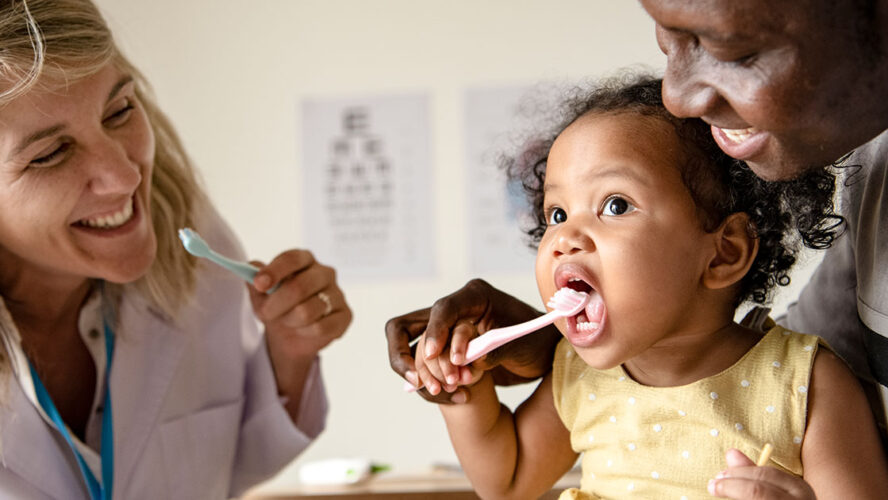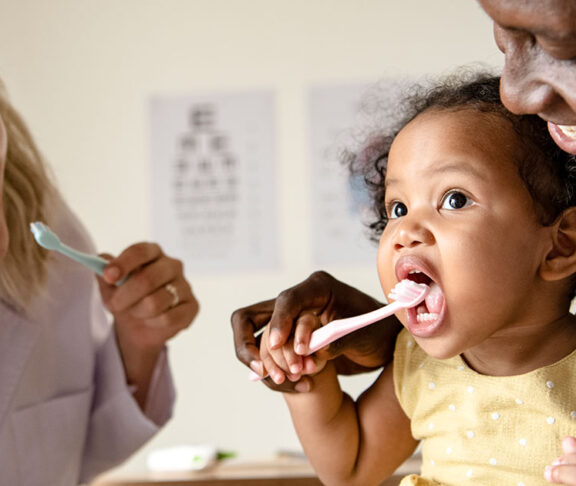A safe and positive pediatric dentistry experience begins at home, and parents play an important role in building healthy habits.
Prior to teeth coming in, gently rub the gums with a cool, wet washcloth. You may place the wet washcloth in the freezer first, but wash it before using it again. As soon as a tooth erupts, clean your child’s teeth at least twice a day with a toothbrush designed for small children.
Once teeth emerge, help your child brush their teeth for two minutes at least twice a day with a toothbrush designed for small children. In children under the age of three years, a smear or rice-sized amount of fluoridated toothpaste should be used.
Brushing at home is a prime time to build the foundation of healthy oral health habits while bonding with your child. To make the experience more fun for everyone, involve your child in selecting a toothbrush, tapping into a favorite character or color. Parents can make a game out of brushing by setting a timer or playing a song that lasts for two minutes while you brush together. Brushing together can show your child how to brush, how often, and for how long. A daily tracker chart is another great way to keep kids engaged and feeling positive about brushing. Print one off with the AAPD Mouth Monsters.
Navigating your child’s first dental visit
Take your child to see a pediatric dentist after their first tooth comes in or by their first birthday, whichever comes first. However, if you have an older child, it is never too late to start taking care of little teeth!
The first dental visit is educational and helps to establish a home base for your child’s dental needs. On the first visit, the pediatric dentist will examine your child’s teeth and may also discuss brushing techniques or take a model of the child’s teeth, depending on the stage of growth. Because pediatric dentists receive 2-3 years of additional training beyond dental school, they are experienced in making your child feel comfortable during the visit and will help ensure you have the necessary tools and information to help keep your child cavity-free.
To prepare for the visit, answer all your child’s questions positively, and be careful about using scary words. Read your child a story or watch a show about a favorite character who had a positive dental experience. You can also give your child some control over the dental visit, asking if they’d like to bring along a favorite stuffed animal or what color toothbrush they’d like to bring home.
Preventing tooth decay
Tooth decay is the most common chronic childhood disease in the United States — more common than childhood obesity, asthma, and diabetes. A child with unhealthy teeth is at risk for future oral health problems as an adult, and diet plays a significant role. Encourage your child to drink water instead of juice, and limit the number of times your child snacks during the day. It’s not only the type of snacks but the constant grazing that can wreak havoc on little teeth. For healthy snacks, stick to whole fruits and cheese slices. Don’t be fooled by “healthy” snacks like organic fruit chews or granola bars that are laced with added sugars and can easily get stuck between the teeth. Candy and treats are fine in moderation, but consider sticking with chocolate rather than sticky or tacky gummies or lollipops.
Your child’s pediatric dentist will be your most important partner in ensuring your child has the best oral health possible. Need to find a pediatric dentist near you? Use the American Academy of Pediatric Dentistry’s “Find a Pediatric Dentist” tool.

